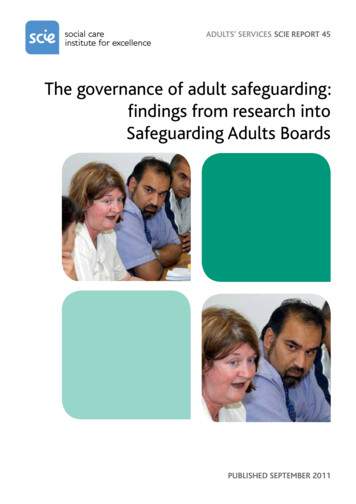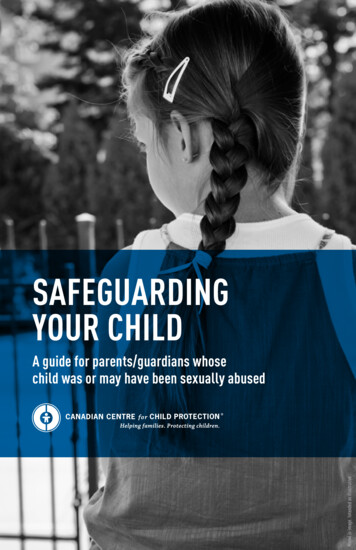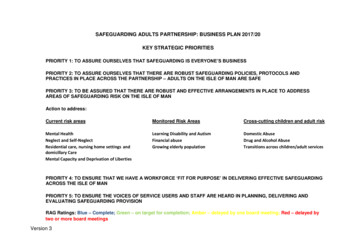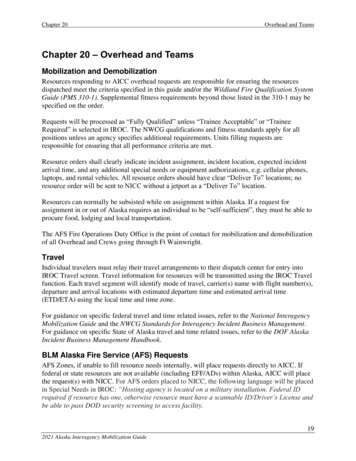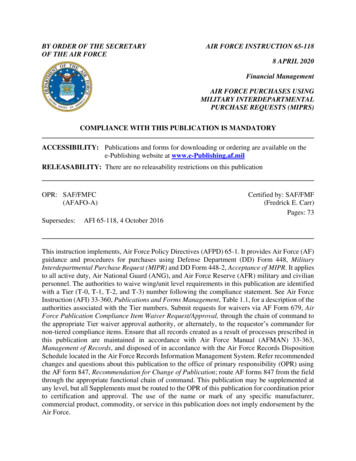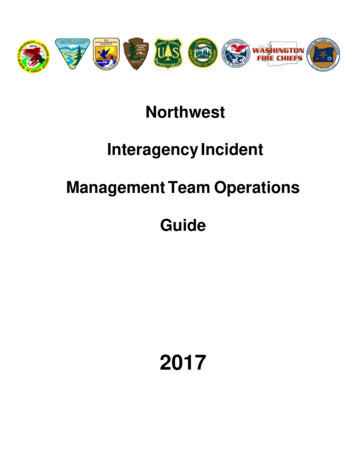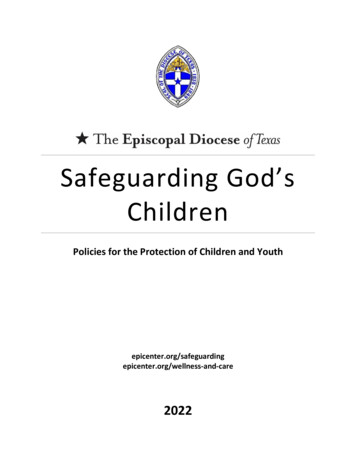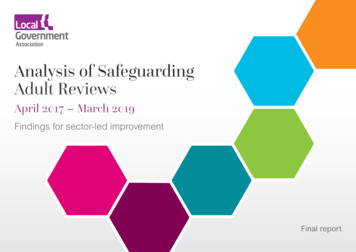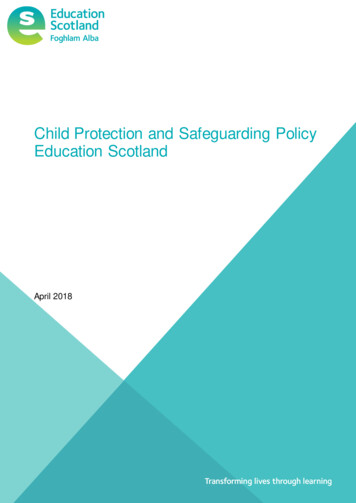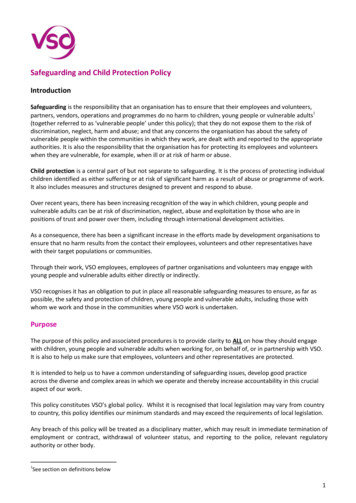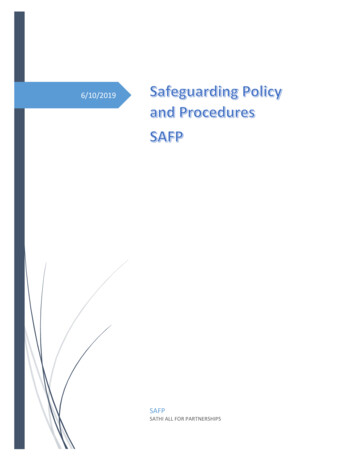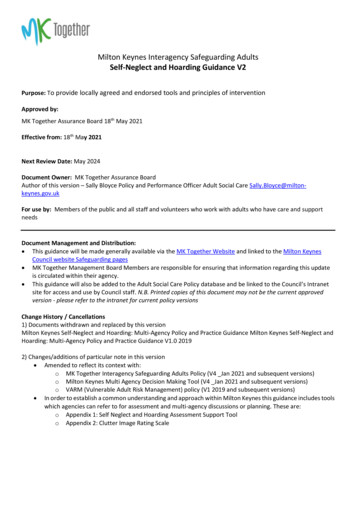
Transcription
Milton Keynes Interagency Safeguarding AdultsSelf-Neglect and Hoarding Guidance V2Purpose: To provide locally agreed and endorsed tools and principles of interventionApproved by:MK Together Assurance Board 18th May 2021Effective from: 18th May 2021Next Review Date: May 2024Document Owner: MK Together Assurance BoardAuthor of this version – Sally Bloyce Policy and Performance Officer Adult Social Care Sally.Bloyce@miltonkeynes.gov.ukFor use by: Members of the public and all staff and volunteers who work with adults who have care and supportneedsDocument Management and Distribution: This guidance will be made generally available via the MK Together Website and linked to the Milton KeynesCouncil website Safeguarding pages MK Together Management Board Members are responsible for ensuring that information regarding this updateis circulated within their agency. This guidance will also be added to the Adult Social Care Policy database and be linked to the Council’s Intranetsite for access and use by Council staff. N.B. Printed copies of this document may not be the current approvedversion - please refer to the intranet for current policy versionsChange History / Cancellations1) Documents withdrawn and replaced by this versionMilton Keynes Self-Neglect and Hoarding: Multi-Agency Policy and Practice Guidance Milton Keynes Self-Neglect andHoarding: Multi-Agency Policy and Practice Guidance V1.0 20192) Changes/additions of particular note in this version Amended to reflect its context with:o MK Together Interagency Safeguarding Adults Policy (V4 Jan 2021 and subsequent versions)o Milton Keynes Multi Agency Decision Making Tool (V4 Jan 2021 and subsequent versions)o VARM (Vulnerable Adult Risk Management) policy (V1 2019 and subsequent versions) In order to establish a common understanding and approach within Milton Keynes this guidance includes toolswhich agencies can refer to for assessment and multi-agency discussions or planning. These are:o Appendix 1: Self Neglect and Hoarding Assessment Support Toolo Appendix 2: Clutter Image Rating Scale
MK Together Self-neglect and Hoarding Guidance – 18 May 2021ContentsSelf-Neglect and Hoarding Guidance V2 . 1Section 1. Introduction . 2Section 2. Definitions . 3Section 3. The local interagency process for self-neglect and hoarding . 3Section 4. Assessment of self-neglect and hoarding . 4Section 5. Intervention options and legislative basis. 5Section 6. Record keeping, information sharing and confidentiality. 7Appendix 1: Self-Neglect and Hoarding Factors (to support the Safeguarding Decision-Making Tool) . 8Appendix 2: Clutter Image Rating Scale . 10Section 1. Introduction1.1 This guidance has been produced by the MKTogether Partnership as part of its Adult Safeguarding Strategy It should be used when dealing with concerns relating to self-neglect and hoarding behaviour. It seeks to ensure that any person can refer to information which promotes workable strategies and supportspositive outcomes for the individuals involved. It MUST be read and used alongside:o MK Together Interagency Safeguarding Adults Policy (V4 Jan 2021 and subsequent versions)o Milton Keynes Multi Agency Decision Making Tool (V4 Jan 2021 and subsequent versions)o VARM (Vulnerable Adult Risk Management) policy (V1 2019 and subsequent versions) This guidance does not include issues of risk associated with deliberate self-harm. If self-harm appears to haveoccurred due to an act of neglect or inaction by another individual or service, consideration should be givento raising a safeguarding adults concern with Adult Social Care. If there is an immediate threat to life call 999.1.2 Self-neglect and hoarding are not lifestyle choices, they are a result of a number of issues and challenges uniqueto each person, our role is to support people to look at their challenges and issues and work with them to maintaintheir tenancy and give them an opportunity to look at how they can change their situation. It is essential that everyeffort is made to engage and involve the adult deemed to be self-neglectful or hoarding and to keep them, theirviews and wishes central to the process. It may not be possible to ‘resolve’ the concern and the aim should then be to reduce risks to an acceptable ormanageable level. It should be recognised that it may take time to effect any change, working at the pace and with the consentof the relevant person wherever possible, and a situation may fluctuate.1.3 Self-neglect and compulsive hoarding require a collaborative interagency approach which must ensure: a shared understanding, and recognition of the issues involved in working with individuals who self-neglect. effective multi-agency working, and practice and ensuring concerns receive appropriate prioritisation.Intervention plans must be agreed on a multiagency basis and have clearly recorded aims, responsibility andtimescales. These plans should be regularly reviewed. all agencies and organisations uphold their duties of care. individuals are empowered, as far as possible, to understand the implications of their actions and/orbehaviours assessment, risk management and agreed interventions are proportionate and take account of the impact ofthe self-neglect on:o the relevant individualo other household and family memberso neighbouring properties and the local environmento utility, health and social care or emergency services staff who may be required to enter the relevantproperty (or adjoining properties) to carry out statutory or public safety tasks. Enforcement action(s) should be viewed as a last resort when necessary to protect serious or immediate risksto wellbeing of the individual, other people or the immediate environment.Uncontrolled version if printedPage 2 of 10
MK Together Self-neglect and Hoarding Guidance – 18 May 2021Section 2. Definitions2.1 Self-neglect – “This covers a wide range of behaviour neglecting to care for one’s personal hygiene, health orsurroundings and includes behaviour such as hoarding”. Ref Care Act Statutory Guidance S14.17 Self-neglect differs from other safeguarding concerns and forms of neglect as it may suggest there is no-oneelse involved as the source of risk, however, abuse or coercion cannot be ruled out as a purpose for becomingself-neglectful.2.2 Hoarding - Anything can be hoarded, inanimate objects, animals or data, in a person’s property, garden orcommunal areas. The main difference between a hoarder and a collector is that hoarders have strong emotional attachmentsto their objects, which can be well in excess of the real value, and stores them in a chaotic manner, usuallyresulting in unmanageable amounts of clutter. Hoarding can become a significant problem if:o The amount of clutter interferes with everyday living, for example, the person is unable to use theirkitchen or bathroom and cannot access rooms within their property.o The clutter is causing significant distress or negatively impacting the quality of life of the person ortheir family, for example, they become upset if someone tries to clear the clutter and their relationshipsuffers as a result Hoarding is a standalone mental disorder, which can be diagnosed by a specialist medical practitioner, it canalso be a symptom of other mental disorders.2.3 For characteristics and behaviours associated with self-neglect and hoarding please see Appendices 1 & 22.4 In places where this document only refers to “self-neglect”, this also includes hoarding.Section 3. The local interagency process for self-neglect and hoarding3.2 The Milton Keynes Multi-Agency Decision Making Tool must be used to determine the response to any concerns: The tool includes specific indicators related to self-neglect (reproduced below). The tool also includes indicators of other ‘types’ of abuse which may provide more relevant or additionalinformation for the current concern or indicate other appropriate interventions.Uncontrolled version if printedPage 3 of 10
MK Together Self-neglect and Hoarding Guidance – 18 May 20213.3 The organisation which initially identifies a concern or receives a referral with a concern about self-neglect isresponsible for ensuring that any immediate action to safeguard the adult or any other person(s) who are beingaffected is taken.3.4 The organisation must then respond to the concern, as appropriate, taking into account the Resolve / Consult /Report criteria within the Decision-Making Tool.3.5 It may be agreed to be appropriate to use the VARM (Vulnerable Adult Risk Management) process.Section 4. Assessment of self-neglect and hoarding4.1 In order to establish a common understanding and approach within Milton Keynes this guidance includes toolswhich agencies can refer to for assessment and multi-agency discussions or planning. These are: Appendix 1: Self Neglect and Hoarding Assessment Support Tool Appendix 2: Clutter Image Rating Scale4.2 Perceptions of what constitutes self-neglect or is not an acceptable standard within which to live will varyamongst agencies and different people, including the adult. Reported information must be verified and supported byobservations, opinions must be clearly identified as such and attributable so they can be checked or challenged4.3 There are various reasons why people self-neglect. Some people have insight into their behaviour, some may beexperiencing an underlying condition, such as dementia. Assessments should consider the following: Unmet care and support needs Inability to maintain own self-care and household chores Chronic use of substance/ alcohol impacting on executive functioning Parents who hoard (learnt behaviours) Childhood neglect/ childhood trauma/ adverse childhood experiencing The impact of abuse or neglect The impact of experiencing/ witnessing domestic abuse Life changing events e.g. loss of a job, bereavement, loss of social status, loss of accommodation etc The loss of a strongly held value system The loss of independence as a result of an accident, trauma, major ill health or frailtyN.B. This is not an exclusive list and other relevant issues/factors MUST be included4.4 Risk. Assessments must always consider the risks to the individual, their household (people and animals) andwider family and the impact of their behaviour on their immediate environment and neighbouring propertiesparticularly in the case of fire or public health and environmental health concerns. If there are any children in the household or family who, may need support or who are at risk. Child protectionor child in need concerns, must be referred to the Multi-Agency Safeguarding Hub (MASH) during office hourson 01908 253169/70 or the Emergency Social Work Team out of office hours on 01908 265545children@milton-keynes.gov.uk4.5 Mental Capacity. If there are any doubts about the person’s ability to 'choose' their living conditions, understandtheir options (and the implications of these), carry out actions, make ‘unwise decisions’ or refuse support, a MentalCapacity Assessment must be undertaken.4.6 Advocacy and Support. All efforts must be made to keep the adult central in the response to suspected of selfneglect and ensure that they are consulted with and included in discussions and decisions. If the adult hassubstantial difficulty doing this an advocate must be considered.4.6.1 If a family member or friend is willing and able to facilitate the adult’s involvement and is acceptable tothe adult and judged appropriate by the involved agency(s), they may be asked to support them.4.6.2 Where there is no appropriate family member or friend there should be an independent advocate.4.6.3 If an adult has difficulty communicating consideration will need to be given as to whether a specialistadvocate or interpreter is needed.4.6.4 Milton Keynes Council Joint Commissioning Team arranges Advocacy Services required, by law, to beinstructed by the Council: where an adult is being assessed under the Care Act adults subject to a safeguarding enquiry or safeguarding adults review if an adult lacks capacity, for decisions about a long-term change in where the adult lives anIndependent Mental Capacity Advocate (IMCA) must be involved.Uncontrolled version if printedPage 4 of 10
MK Together Self-neglect and Hoarding Guidance – 18 May 20214.7 Consent and Choice. Where an adult has mental capacity in relation to the relevant decisions, any proposedintervention or action must be with their consent, except in the public interest where other people are affected orcircumstances where a local authority or agency exercises their statutory duties or powers.4.8 Duty of Care. Workers must be aware of their Duty of Care and the appropriate use of Inherent Jurisdiction RefSection 5.12. This includes situations where a person who is the subject of a concern cannot be contacted. It isessential to establish the reason(s) why by: seeking information which may explain the lack of response. This may include: Social Care/ council services/GP/other professionals, relatives, friends, neighbours, local hospitals etc.a home visit where, if there is no response, a visiting card/letter must be left (even if someone isseen to be present but does not open the door).further checks, information gathering and attempts to contact the individual including a followup home visit(s) the same day or within a few days depending on the level of risk identified.4.8.2 A concern should not be ignored ‘simply’ because of a ‘nil-response’ or no response within a specifiedtimeframe, it should always be established why.4.8.3 As necessary ‘nil response’ concerns should be escalated within the organisation to decide furtheraction(s) which may include a request to the Police for a welfare visit.For additional assessment tools and useful background information please see: Social Care Institute for Excellence (SCIE) Self Neglect https://www.scie.org.uk/self-neglect Self Neglect at aGlance S Website – Hoarding Disorder cks Fire and Rescue Service: Fire and Wellness visits visits/Help for hoarders (Charity) https://www.helpforhoarders.co.uk/HoardingUK (Charity) https://www.hoardinguk.org/RSPCA - Animal Welfare and Hoarding ntionN.B. Specialist Hoarding and Cleaning companies – should be used with caution as part of a care planSection 5. Intervention options and legislative basis.5.1 There is a range of agencies and interventions that may be appropriate for dealing with a situation of selfneglect. Interventions must be adult specific and where there is a potential need for legal intervention the agencywhich holds that statutory power must be consulted and involved in the agreed action.5.1.1 The main legislation and relevant services are listed below, where necessary agencies should seek legaladvice to clarify the options and any intended intervention.5.2 MKC Adult Social Care. The Care Act (2014) Section 1: Duty to promote wellbeing which includes personal dignity, physical and mental health andemotional wellbeing, protection from abuse and neglect, control by the individual over their day-to-day life(including over care and support provided and the way they are provided), social and economic wellbeing,domestic, family and personal domains, suitability of the individual’s living accommodation. Section 42: Duty to make enquiries in response to allegations of abuse or neglect – self-neglect is included asa category under adult safeguarding.5.3 MKC Environmental Health Services have a range of powers to intervene where an individual or a property is ina condition that is prejudicial to health, or where the premises are materially affecting neighbouring premises ( e.g. aperson is crawling with lice or bedbugs etc or a property is verminous) or pose a statutory nuisance.5.4 MKC Housing Department has powers to take enforcement action where there is any risk of harm to the healthor safety of an occupier of an MKC Council Home which arises from a deficiency within in the home or in any MKCUncontrolled version if printedPage 5 of 10
MK Together Self-neglect and Hoarding Guidance – 18 May 2021owned building or land in the vicinity (whether the deficiency arises as a result of the construction of any building, anabsence of maintenance or repair, or otherwise).5.5 Private landlords/housing associations and registered social landlords have an obligation to ensure that theirproperties are in a good state of repair and are fit for human habitation. Where the tenant is responsible for thedisrepair the landlord has a right of action, including ultimately seeking possession of the premises.5.6 NHS/Local Mental Health service Mental Health Act (2007)o Section 2: Admission for assessmento Section 3: Admission for treatmento Section 4: Admission for assessment in cases of emergencyo Section 135 – if a person is believed to have a mental disorder and they are living alone and unable to carefor themselves, a magistrate’s court can authorise entry to remove them to a place of safety5.7 Buckinghamshire Fire & Rescue Service (BFRS): should be made aware when agencies are working with a personwho hoards (to the extreme). BFRS can work with individuals to reduce fire risks. It is also important for BFRS tounderstand where premises with this risk are located to inform emergency response. Enforcement action isexceptional and only applies if the fire risk in a dwelling is extremely high with the hoarded material or behaviourimpacting on the common parts of a building or placing other residents at risk in a building which falls under theRegulatory Reform (Fire Safety) Order 2005.5.8 Thames Valley Police have the power to enter a property without a warrant if required to save life or limb; orprevent serious damage to property. A Community Protection Notices (CPN’s) or Community Protection Order(CBO’s), can be used if there is persistent conduct which causes or is likely to cause alarm, distress or harassment orto the quality of life of a resident or visitor to the area.N.B. MKC Antisocial Behaviour Team can also issue CPN’s and CPO’S5.9 Department for Environment, Food and Rural Affairs (Defra) is the Government body tasked with enforcinganimal welfare legislation in England and Wales, specifically the Animal Welfare Act 2006 which makes it against thelaw to be cruel to an animal, and a person must ensure that the welfare needs of the animals are met.5.9.1 Animal cruelty in a domestic situation is likely to fall to the RSPCA or Local Authority (MKC TradingStandards Team) who have enforcement powers under the Animal Welfare Act 20065.10 Court of Protection has the power to make an order under Mental Capacity Act (2005) s.16(2)(a) – regarding adecision on behalf of an individual. The court’s decision about the welfare of an individual who is self-neglecting mayinclude allowing access to assess capacity5.11 All organisations - 5.3 Human Rights Act 1998 Article 8 The right to respect for private and family life is not anabsolute right and there may be justification to override it, e.g, protection of health, prevention of crime, protectionof the rights and freedoms of others.5.12 All Organisations - Duty of care / Inherent jurisdiction. All organisations and individual workers have a Duty ofCare (established through common law) which can be summarised as the obligation to exercise a level of caretowards an individual, as is reasonable in all circumstances, by taking into account the potential harm that may bereasonably caused to that individual or their property. Respect for autonomy and self-determination must always be balanced against the duty of care and promotionof dignity and wellbeing. If you are concerned about a person you MUST make appropriate enquiries and seek advice regardingappropriate intervention, doing nothing is not an option Inherent jurisdiction is the ability of the High Court to make declarations and orders to protect adults whohave mental capacity to make relevant decisions but are vulnerable. It is used by High Court judges to fill thegap left by the fact the Mental Capacity Act (‘MCA 2005’) only applies to those lacking mental capacity applyingthe test in ss.2-3 of that Act The inherent jurisdiction is not limited to giving a person at risk of abuse and neglect a temporary ‘safe space’but can impose long-term legal directives to protect the person at risk.Uncontrolled version if printedPage 6 of 10
MK Together Self-neglect and Hoarding Guidance – 18 May 2021Section 6. Record keeping, information sharing and confidentiality6.1 Individual organisations must keep their own, up to date, records of their specific involvement (informationreceived or gathered, discussions, meetings and actions in relation to the concern) they should refer to their localrecords management policy regarding this.6.2 Where there is interagency involvement there must be reference to this in the individual agency record, it mustbe clear who is responsible for any record of shared decision-making.6.3 When deciding whether to share information, each case must be judged on its own facts. Decisions must bejustifiable and proportionate ensuring that the information shared: is relevant and necessary (not simply all the information held) shared only with the relevant people who need the information, and specifically needed at that time. balances the duty to protect people with care and support needs from actual or potential harm or abuse andthe effect upon individuals of information about them being shared (for example, upon the person’s Article 8Human Rights (the right to private and family life).Uncontrolled version if printedPage 7 of 10
MK Together Self-neglect and Hoarding Guidance – 18 May 2021Appendix 1: Self-Neglect and Hoarding Factors (to support the Safeguarding Decision-Making Tool)This table aims to aid multi-agency discussion, planning and decision-making. Factors in bold are taken directly from the DMT other factors are for additional clarity.Worker(s) MUST verify and evidence information e.g. by observation /discussions / home visit(s) and Mental Capacity and Risk Management MUST be integral to this.FACTORPHYSICAL WELLBEING AND SELFCARE:Eating anddrinkingPHYSICAL WELLBEING AND SELFCARE:RESOLVE- Low risk or care and support needs where all actionsto prevent abuse or protect an adult from abuse arerecorded. - The adult's needs are met through localsupport services accessed via appropriate referralroutes.- A level of concern that can be resolved through caremanagement, complaints, staff training, case reviews,quality processes or contract managementCONSULT- Moderate risk and or moderate care and supportneeds.- Concerns at this point may be reportable and mustbe considered on a case by case basis. The adult'sviews must be considered.- Advice should be sought from your organisation'sAdult Safeguarding Lead or the Council’s AdultSafeguarding Team on 01908 252835.REPORT- If the adult/s have been seriously harmed or at riskof serious harm because of actions, or omissions,deliberate or unintentional of others, then report as asafeguarding concern to Milton Keynes Council.- If there is indication that a criminal act has occurred,and the matter is urgent, contact the Police.- Self-care causing some concern - no signs ofharm or distress- Quality of food and/or drink inconsistentthrough lack of knowledge or effort- Quality of food and/or drink is consistentlypoor through lack of effort; consistent supportrequired to improve any quality- Poor food safety.- May be experiencing health related issues- Occasionally bathed but seldom groomed.- Clothing often dirty and/or unsuitable toweather conditions- Concerns that this maybe having an impact onhealth of low-level concern which is responsiveto treatment in the community- Self-neglect is life threatening- Quality and frequency of food and/or drinkconsistently not a priority despite support- Health issues of concern e.g. dehydration,malnutrition, infection, significant weight loss- Seldom/never bathed or clean, concernregarding odour.- Dirty and/or poor condition of clothing(unsuitable to weather conditions)- Poor health of significant concern (Skininfections, sores, abscesses. Likely tounmanageable within community setting).- Life in danger without intervention- Only seeks help when illness becomes critical(emergencies)- Ignores critical ill health- Fails to consistently take medication leading toill-health and frequent hospital admissions- Significant mental ill-health- Lack of self-care results in significantdeterioration in health/wellbeing/safety- Chaotic substance misuse- Irregular bathing and occasional weatherinappropriate clothingWashing/bathingPHYSICAL WELLBEING AND SELFCARE:Medical needs- Occasionally fails to keep medicalappointments- Refusing/non-engagement with medicaltreatment/care/equipment required tomaintain independence and health- Only seeks advice when illness becomesmoderately severe.- Fails to keep some medical appointments andtakes only partial medical advice- Problematic or chaotic substance misuseUncontrolled version if printedPage 8 of 10
MK Together Self-neglect and Hoarding Guidance – 18 May ITIONS:Home andgardencleanlinessLIVINGCONDITIONS:Home safetyand ownviews ofsafety inhome andenvironmentRESOLVE- Property shows some signs of neglect /Property neglected but all main services work- Some repairs needed and amenable to repair orto self-repair- Some evidence of hoarding - no major impacton health/safety- Level of untidiness may be having some impacton well-being, but manageable (ref clutter scorepic 2)- All doors and windows in use and accessible– Lacking/insufficient essential safety features(e.g. Smoke alarms)- Possible fire risk/ no escape plan- DIY that is not safe, overloaded electrical socketsor trailing extension leads- Variable awareness and perception of personalsafety issues-Behaviour does not cause concern for others- No access to support /First signs of not engaging with professionalsANIMALSAND PESTS- Any pets at the property are well cared for- Animal waste appropriately disposed- No pests or infestations at the propertyCONSULT- Lack of essential amenities- Lack of access to essential amenities due tohoarding / unwholesome conditionsREPORT- Little or no essential amenities /- Hoardingprevents safe use of amenities within the home- no access to kitchen/bathroom /bedroom- Dangerous disrepair and significant risk to well- Home in disrepair and unable and /orbeing of person and/or othersunamenable repair- Property/environment shows signs of neglect- Environment injurious to healththat are potentially damaging to health- Dirty (bad odour)- High level of clutter/hoarding- Waste significantly impacting person’s health- Dirty (bad odour), some infestationsand well-being (ref clutter score pic 7 -9)- Animal/human/food waste impacting person’s- Tenancy at risk because of hoarding/propertyhealth and well-being (ref clutter score pic 4 - 6)condition, i.e. notice served- Limited access to windows/doors- Access obstructed within property- No essential safety features- No essential safety features.- Potential fire risk/gas leaks and no escape plan/ - Imminent fire risk/gas leaks and no escapehazards to escape. Evidence of smoking and/or plan/definite hazards to escape route/cannot exitflammable items stored in the home (stock-piled/ unaided. Evidence of fire/cigarette burns toirresponsible use)clothes, bedding or rooms and/or unsafe- Unable to use bed, sleeps in an alternative duestorage or use of flammable liquids or gases.to clutter/ hygiene.- Unable to use bed, sleeps in uncomfortable- Home insecure due to disrepair/insanitary conditions- Oblivious to personal safety issues- Unconcerned about personal safety issues.- Behaviour raises concern for others- Lacks motivation or understanding to address- Not engaging with professionalsconcerns- Reluctant to accept advice/ lack of motivation or - Multiple reports from other agenciesunderstanding- Behaviour poses risk to self/others- Resident is not unable to control the animals- Animals at the property at risk due the level of- Animal’s living area is not maintained and smells clutter in the property- Animals appear under nourished or overfed or- Hoarding of animals at the propertypossibly suffering ill health- Animals significantly undernourished or overfed- Animal waste inappropriately disposedor appear to be suffering ill health- Sound of rodents heard at the property.- Animal waste evident- Light insect infestation (bed bugs, lice, fleas,- Visible rodent infestationcockroaches, ants, etc.)- Heavy insect infestation (lice, fleas, etc.)Uncontrolled version if printedPage 9 of 10
MK Together Self-neglect and Hoarding Guidance – 18 May 2021Appendix 2: Clutter Image Rating ScaleThese images can be used by selecting a photo that most accurately reflects the amount of clutter in the room. For a full ‘set’ of phot
MK Together Self-neglect and Hoarding Guidance - 18 May 2021 Uncontrolled version if printed Page 3 of 10 Section 2. Definitions 2.1 Self-neglect - "This covers a wide range of behaviour neglecting to care for one's personal hygiene, health or surroundings and includes behaviour such as hoarding"
